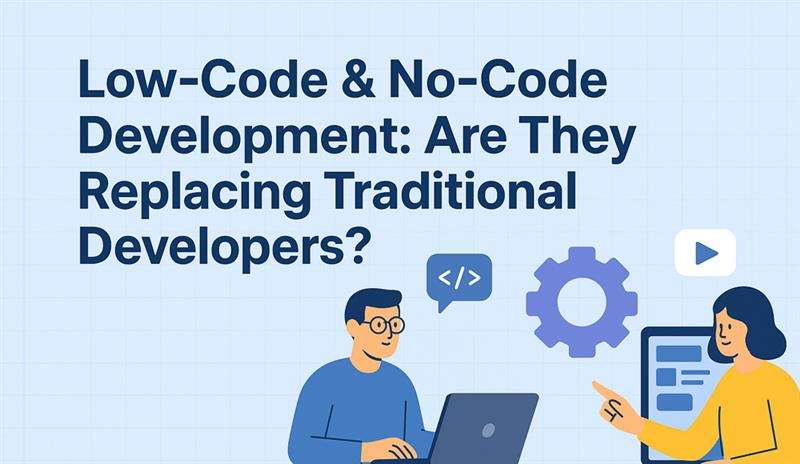
Introduction
Over the last few years, low-code and no-code (LCNC) development platforms have transformed the way businesses build applications. With the rise of tools like Power Apps, Bubble, OutSystems, AppSheet, Kissflow, and Mendix, even non-technical users can now build apps faster than ever before.
This rapid evolution has sparked a big question:
“Will low-code & no-code platforms replace traditional developers?”
The short answer is No — but they will redefine the role of developers and accelerate digital transformation.
In this detailed guide, we’ll explore the capabilities, limitations, and future of LCNC, and whether developers need to worry about job loss in 2025 and beyond.
Hire a Developer
What Is Low-Code Development?
Low-code development allows users to build applications using drag-and-drop interfaces, pre-built modules, and minimal hand-written code.
It is designed for:
- Developers who want faster delivery
- IT teams building internal tools
- Businesses automating workflows
Common Low-Code Features:
- Visual workflows
- Pre-built UI components
- API integrations
- Automation engines
- Custom scripting options
What Is No-Code Development?
No-code platforms allow users with zero programming knowledge to build apps using visual design tools. These users are often referred to as citizen developers.
Best For:
- Small businesses
- Marketing teams
- Operations teams
- Startups validating ideas
Typical No-Code Tools:
- Bubble
- Webflow
- Airtable
- Wix
- Zapier
- Glide
Why Low-Code/No-Code Is Growing So Fast (2025 Trends)
The LCNC market is booming due to:
- Shortage of skilled developers
Businesses need apps faster than developers can build them. - Rapid digital transformation
Organizations must digitize operations and automate workflows to stay competitive. - Lower development cost
No-code eliminates the need for expensive custom development for simple apps. - Faster time-to-market
Apps that once took months can now be built in days. - Integration with AI
AI-powered LCNC builders can now generate app logic, automate testing, and provide architecture suggestions.
Advantages of Low-Code & No-Code Development
- Speed & Efficiency
Apps are built 5x–10x faster than traditional coding. - Lower Costs
Fewer developer hours = lower project cost. - Empowerment of Non-Technical Users
Teams like HR, sales, ops, and finance can create their own solutions. - High Flexibility with Pre-Built Components
Users get templates for forms, dashboards, workflows, and databases. - Easy Integration
Modern platforms integrate with:- CRMs
- ERPs
- Cloud services
- APIs
- Zapier
- Databases
- Faster Prototyping
Startups and enterprises can build MVPs quickly before investing in custom apps.
Limitations: What LCNC Cannot Replace
Despite rapid advancements, low-code/no-code platforms still have major limitations.
- Complex, Scalable Systems Still Require Coding
Enterprise-level apps involving:- Real-time processing
- Big-data pipelines
- Multi-layer architectures
- Custom APIs
- Microservices: cannot be built using no-code tools alone.
- Security & Compliance Concerns
Highly regulated industries (finance, healthcare) often require:- Custom security
- Data compliance
- On-premise hosting
- Zero-trust architecture
- Limited Customization
No-code platforms break down when the app requires:- Deep backend logic
- Custom integrations
- Advanced performance tuning
- Vendor Lock-In
Once you build on a platform, migrating away can be difficult and expensive.
Will They Replace Traditional Developers? The Real Answer
❌ No, low-code & no-code will not replace traditional developers.
✔ But they will change their role dramatically.
Low-code platforms still require developers for:
- Writing custom extensions
- Building APIs
- Creating complex backend logic
- Integrating multiple systems
- Ensuring performance & security
- Managing enterprise architectures
Think of LCNC as a power tool — not a replacement.
Just like Excel didn’t replace data analysts, LCNC won’t replace developers. It simply makes them more productive.
How LCNC Affects Developers (New Roles in 2025)
- Developers become system architects
Instead of writing every line of code, developers focus on building secure, scalable frameworks. - Developers become integrators
Connecting LCNC apps with enterprise systems, APIs, and cloud platforms. - Developers become automation supervisors
Ensuring LCNC automations follow best practices. - Developers write custom modules
Low-code tools allow custom code plugins that developers maintain. - Developers lead governance
Enterprises need coding experts to:- Set policies
- Manage security
- Maintain standards
Result: Developers gain more strategic roles, not fewer.
Who Will Be Replaced?
Low-code/no-code doesn’t replace developers — but it can reduce the need for:
- Small freelance developers
- Junior developers handling repetitive tasks
- Teams that build simple CRUD apps
- Manual workflow builders
Because these tasks can be automated by LCNC platforms.
Real-World Use Cases of LCNC in 2025
- Internal Business Tools
HR systems, inventory tracking, CRM add-ons. - Workflow Automation
Approvals, notifications, reporting. - MVPs for Startups
Founders can create prototypes without hiring developers. - Customer Portals
Simple dashboards, forms, feedback systems. - AI-Assisted Applications
Platforms now include:- Auto-generated UI
- AI workflows
- Smart automation
Low-Code/No-Code vs Traditional Development
| Category | Low-Code / No-Code | Traditional Development |
|---|---|---|
| Speed | Very fast | Slower but precise |
| Cost | Low to moderate | High |
| Complexity | Basic–Moderate | Unlimited |
| Customization | Limited | Fully customizable |
| Scalability | Moderate | High |
| Security | Platform-dependent | Fully controlled |
| Best For | Internal tools, automations, MVPs | Enterprise apps, scalable systems |
FAQ: Low-Code & No-Code Development
What is no-code development?
No-code development enables non-technical users — often called citizen developers — to create applications using drag-and-drop tools without writing any code. It is commonly used for workflow automation, simple apps, dashboards, and prototypes.
Will low-code or no-code platforms replace traditional developers?
No. Low-code and no-code platforms will not replace traditional developers. Instead, they enhance productivity by automating repetitive tasks and allowing developers to focus on complex logic, architecture, integrations, and scalable systems.
What types of applications can be built using low-code or no-code?
Low-code/no-code platforms are ideal for building:
Internal business tools
Customer portals
Workflow automation apps
Basic CRMs and dashboards
MVPs for startups
Form-based applications
Highly complex or large-scale systems still require traditional coding.
What are the limitations of no-code platforms?
No-code platforms have limitations such as:
Limited customization
Performance constraints
Vendor lock-in
Restricted backend control
Security and compliance concerns
These platforms are not suitable for enterprise-level or highly scalable apps.
What are the benefits of low-code development for businesses?
Key benefits include:
Faster development cycles
Lower cost
Increased innovation
Empowerment of non-technical teams
Easy integration with existing systems
Reduced workload on IT teams
Is low-code secure for enterprise use?
Yes, many enterprise-level low-code platforms include built-in security, compliance certifications, data encryption, audit logs, and access-control features. However, security still depends on proper governance, IT oversight, and architecture decisions.
How does AI integrate with low-code/no-code platforms?
AI enhances LCNC platforms by enabling:
Automated code generation
Intelligent workflow suggestions
Natural language app building
AI-based testing and debugging
Smart automation and decision-making
This fusion leads to faster and more accurate application development.
Who should use low-code vs no-code?
No-code is best for non-technical users building simple apps, automations, or prototypes.
Low-code is ideal for technical users and developers building mid-level apps that require integrations, custom logic, and scalability.
What is the future of low-code and no-code development?
The future includes:
AI-powered app builders
Hybrid development (code + no-code)
Industry-specific templates
Enterprise adoption at scale
More automation and workflow intelligence
Future of LCNC: What to Expect by 2030
- AI-driven app builders (AI writes the app for you)
- Auto-generated workflows based on prompts
- Industry-specific LCNC templates
- Hybrid development (mix of code + no-code)
- Large enterprises adopting LCNC at scale
The future is not about replacing developers — it’s about augmenting them.
Conclusion
Low-code and no-code platforms are powerful tools that are reshaping the software development landscape. But they are not replacing traditional developers — they’re simply shifting their responsibilities and empowering more people to participate in application development.
Businesses that adopt LCNC alongside traditional development will gain:
- Faster delivery
- Lower costs
- Higher innovation
- Increased efficiency
The most successful organizations in 2025 and beyond will be those that combine:
LCNC + Traditional Coding + AI + Strong Developer Teams













